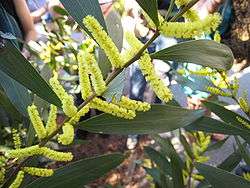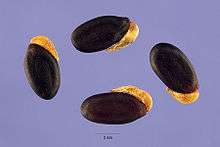Acacia longifolia
| Acacia longifolia | |
|---|---|
 | |
| Foliage and blossoms of Acacia longifolia | |
| Scientific classification | |
| Kingdom: | Plantae |
| (unranked): | Angiosperms |
| (unranked): | Eudicots |
| (unranked): | Rosids |
| Order: | Fabales |
| Family: | Fabaceae |
| Genus: | Acacia |
| Species: | A. longifolia |
| Binomial name | |
| Acacia longifolia (Andr.) Willd. | |
 | |
| Range of Acacia longifolia | |
| Synonyms | |
Acacia longifolia is a species of Acacia native to southeastern Australia, from the extreme southeast of Queensland, eastern New South Wales, eastern and southern Victoria, and southeastern South Australia. Common names for it include long-leaved wattle, acacia trinervis, aroma doble, golden wattle, coast wattle, sallow wattle and Sydney golden wattle. It is not listed as being a threatened species,[2][3] and is considered invasive in Portugal and South Africa.[4] It is a tree that grows very quickly reaching 7–10 m in five to six years.[5]
Subspecies
There are two subspecies:[2]
- Acacia longifolia subsp. longifolia
- Acacia longifolia subsp. sophorae (Labill.) Court
Uses
Acacia longifolia is widely cultivated in subtropical regions of the world. Its uses include prevention of soil erosion, food (flowers, seeds and seed pods), yellow dye (from the flowers), green dye (pods) and wood.[6] The flower colour derives from the organic compound kaempferol.[7] The tree's bark has limited use in tanning, primarily for sheepskin. It is useful for securing uninhabited sand in coastal areas, primarily where there are not too many hard frosts.[8]
Control
In South Africa at least, the Pteromalid wasp Trichilogaster acaciaelongifoliae has been introduced from Australia, and has spread rapidly, achieving substantial control.[9] The effect on the trees has been described as drastic seed reduction (typically over 90%) by galling of reproductive buds, and indirect debilitation of the affected plant by increased abscission of inflorescences adjacent to the growing galls. The presence of galls also caused leaf abscission, reducing vegetative growth as well as reproductive output.
_9798.jpg)
Phytochemistry
- N-(2-imidazol-4-yl-ethyl)-trans-cinnamamide[10]
- N-(2-imidazol-4-yl-ethyl)-deca-trans-2, cis-4-dienamide[10]
- dimethyltryptamine 0.2-0.3%, histamine[11]
Gallery
-
Flowering
-

Bushy habitat
-

Cultivated
-

Seeds
-

Illustration
References
- ↑ "Acacia longifolia - ILDIS LegumeWeb". www.ildis.org. Retrieved 2008-05-18.
- 1 2 Australian Plant Name Index: Acacia longifolia
- ↑ What goes here?
- ↑ Vespa australiana pode ajudar a reduzir invasão das acácias
- ↑ Warringah Online
- ↑ Plants for a Future: Acacia longifolia
- ↑ Lycaeum: Phytochemistry Intro
- ↑ Ferdinand Mueller (freiherr von) (1884). Select extra-tropical plants readily eligible for industrial culture or naturalization. G.S. Davis. pp. 7–. Retrieved 28 October 2010.
- ↑ Dennill, G.B. ; The effect of the gall wasp Trichilogaster acaciaelongifoliae (Hymenoptera: Pteromalidae) on reproductive potential and vegetative growth of the weed Acacia longifolia; Agriculture, Ecosystems & Environment, Volume 14, Issues 1-2, November 1985, Pages 53-61
- 1 2 Repke DB (1975). "The histamine amides of Acacia longifolia". Lloydia. 38 (2): 101–5. PMID 1134208.
- ↑ Hegnauer, Robert (1994). Chemotaxonomie der Pflanzen. Springer. ISBN 3-7643-2979-3., Nen in Entheogen Review (journal) 1994-7
| Wikimedia Commons has media related to Acacia longifolia. |
| Wikispecies has information related to: Acacia longifolia |